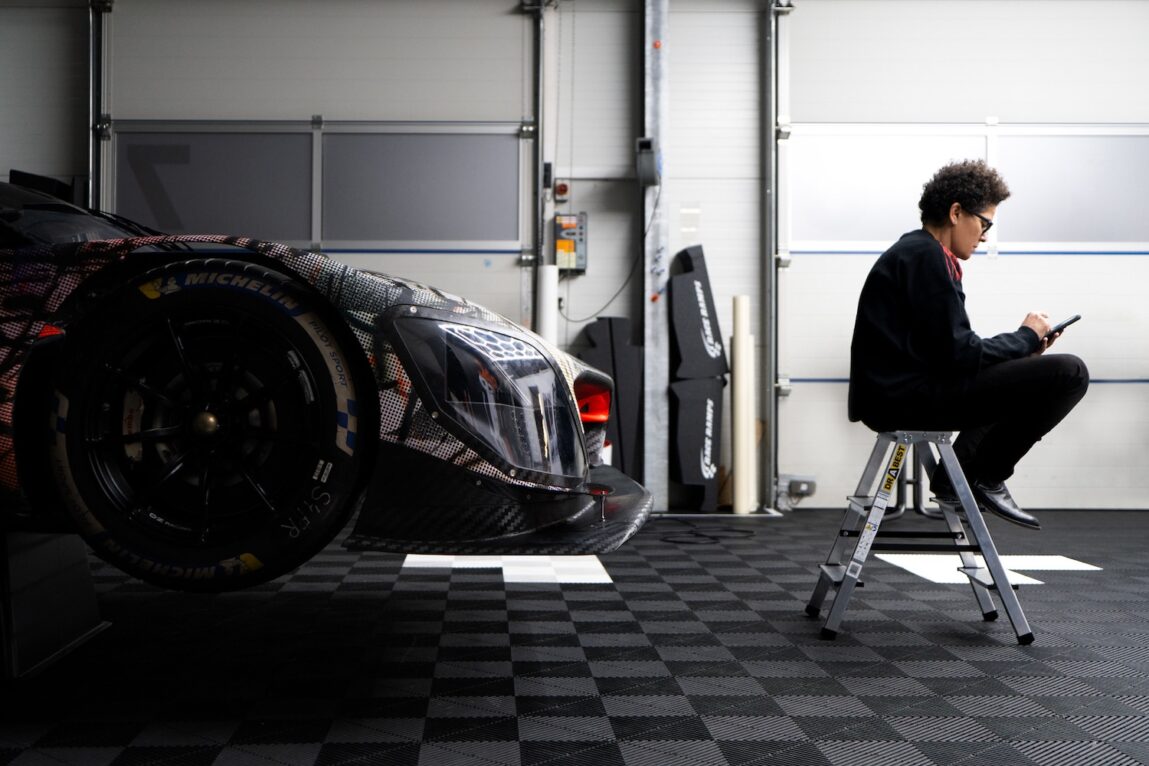TEXT Sarah Wetzlmayr | Coverstory CHAPTER №X »State of the art« — SUMMER 2024
For the design of her BMW Art Car, the artist Julie Mehretu, who is internationally renowned for her large-format, abstract paintings, sent the BMW M Hybrid V8 through one of her pictures. And found that it worked. However, the New York-based artist believed in the transformative power of art even before this project, which was completely new to her, she explains in our interview for the cover story of Chapter №X—»State of the Art«.
With large-format works such as the almost 25-metre-wide mural »Mural«, which hangs in the lobby of the Goldman Sachs headquarters in New York, Julie Mehretu has already broken boundaries on several occasions. With the design of the current BMW Art Car, the artist, who was born in Ethiopia in 1970 and lives in New York, has now finally outgrown both herself and the framework conditions that have previously applied to her art. How is this to be understood? She herself outlines the creation process of her BMW Art Cars as follows: »I sent the car through one of my pictures.« We talk about Zoom and Julie Mehretu laughs. Then she sneezes. »It’s spring in New York«, she says and starts to explain why what I’ve just said is not to be taken literally. »When I was thinking about what the car might look like in the end, I kept thinking about this picture in my studio that I had just finished. The model of the Art Cars was standing next to it and I thought that I could perhaps try to move the car through the painting.« However, this almost mystical attraction between the two objects did not result in Julie Mehretu giving the BMW M Hybrid V8 simply covered an existing outfit. »The painting appears on the car in a remixed form. If you were to place the finished Art Car and the painting next to each other, you could feel that they belong together, but you probably couldn’t really put into words where this feeling comes from«, says Mehretu, before she takes us even deeper into the creative process. For her, it felt as if the car had moved through a kind of portal only to reappear at the other end in a transformed form, she notes. These descriptions, which could also have been taken from a science fiction film, also fit in with the fact that Julie Mehretu describes the BMW M Hybrid V8, which served as her canvas, as »a car of dreams«, which in its form and technical possibilities goes beyond all limits of the imaginable. Or, to put it another way, it pushes the boundaries of what was previously possible when it came to automobiles.
O, YOU BEAUTIFUL BLUR
When she received the request from BMW, she was completely perplexed, recalls Julie Mehretu. At the same time, however, she also felt incredibly honored. »At first, I thought to myself that there was no way I could say yes, because I didn’t even have the slightest idea of how I could go about it.« In spring 2020, when she suddenly had more time to think about it due to the Coronavirus pandemic, she went through the request again in detail. And came to the following conclusion: »I thought to myself: just do it. It’s an incredibly exciting opportunity to immerse myself in something completely new.« She also realized that Okwui Enwezor, whom she held in high esteem until shortly before his death in 2019, was the director of the House of Art in Munich, was a member of the jury. In his statement, he noted the following: »Julie Mehretu’s work encompasses various questions of movement, she brings dynamism into form. Julie has a very clear and well-founded understanding of how the object behaves in space.« Movement is a good keyword, because in order to really get things moving, Julie Mehretu first had to be surrounded by running engines. She attended the Daytona 24-hour race, which gave her the idea of working with blurs and glitches in her BMW Art Car. The starting point from which she began was therefore anything but static, but a collection of moving, shimmering objects. This is why it is far from her intention to describe the vehicle she designed as a sculpture. »It is a work of art, but also a car that will compete in the 24-hour race at Le Mans« , the artist states with her typical clarity. »I am interested in what happens to the car during these 24 hours«, she adds. »How it changes, what marks the track leaves on the vehicle. All these questions have cast the creative process in a completely new light for me. A playground opened up where I could give free rein to my creativity«, says Mehretu. The artist will talk about this playground more often during our conversation—as well as about the new artistic freedom that she was able to open up for herself by working on the BMW Art Car. She adds that there are also many things that she can take from this new experience into her artistic practice. »Above all, the great desire to remix existing material.« So here, too, the route (up to the final Art Car) has left its mark—in the best sense of the word.
FELT AS MUCH AS READ
We will come back to the role that speed and the associated blurring play in her artistic work in more detail. On another level, which is just as important for her work, one thing is clear: Julie Mehretu wants to remain flexible and open. But she also wants her art to be moving—even if, as in most cases, it does not take the form of a hypercar. »I want the work to be felt as much as read«, she once said in an interview. When we asked her why this was the case, she gave her usual direct and unpretentious answer: »I find art exciting above all when it triggers something in me, moves me and sets something in motion. I am particularly interested in the sensual reaction to something. This applies equally to the visual arts, music and other art forms.«

»Mural«, 2009
Ink and acrylic on canvas
7 x 24 m
Goldman Sachs, New York
In reference to the creation process of her Art Car, one could perhaps even compare it to a form of magical portal. In abstraction, Mehretu has found a form of expression that allows her to do just that. For her, abstract space is above all a space full of possibilities that functions independently of our language system and is not about rational understanding and logical classification, but about creating a sensory experience. »It is a different form of knowledge«, she states after a short pause. Anyone talking about abstraction in connection with Julie Mehretu’s artistic work should also mention the term »opacity«, whose direct German translation—»Opazität«—is rarely used in everyday language, but which means something like opacity, intransparency or, in a more figurative sense, impenetrability. In interviews, Julie Mehretu has already quoted the Martinique-born poet Édouard Glissant several times, who once wrote in an essay dedicated to opacity: »We clamor for the right to opacity for everyone.«

»Out of The Dreaming«, 2022 — 2023
Ink and acrylic on canvas
243.8 × 304.8 cm
For her, there is something liberating in the closely associated abstraction, as the artist has already emphasized several times in interviews. However, this does not mean that she wants to renounce all traditions. Quite the opposite. »The way I make art takes place in discourse with other artists and other forms of visual expression—as well as in dialog with the history of abstract painting. I see myself as part of this dialogue«, Julie Mehretu is keen to emphasize. This also applies to the history of the BMW Art Car, with which the artist has been intensively involved. Frank Stella’s grid-like design from 1976 was one of the things that inspired her, says Mehretu. Following on from this, we would like to know from her what it feels like to approach a concrete object, such as a racing car, in an abstract way. She pauses for a moment and then answers in a calm voice: »A vehicle like the BMW M Hybrid V8 is a concrete object, but at the same time incredibly rich in metaphors and history.« Playing with this and exploring the entire spectrum of what a car can be was a great attraction for her, she adds. However, the American conceptual artist Glenn Ligon feels that classifying her work purely as abstract art is too narrow a view. He says: »Julie is the painter I turn to when I want to think about how to trouble the line between abstraction and figuration, between local and global concerns, between painterly restraint and joyous abandon.«
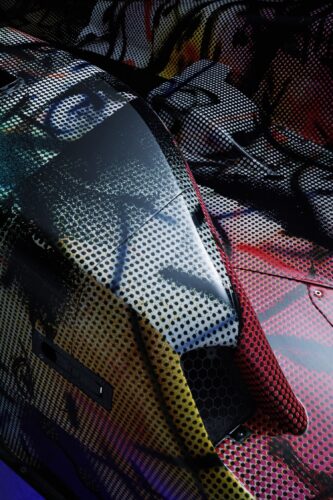
She herself once stated in an interview: »I think that there isn’t this binary between representational work and the abstraction. It’s much more blurry and messy.« And there it is again—the blurriness that also put her on the right track—, so to speak, on the ideal line—when designing her BMW Art Car. And which, as crystallized in an interview with the New York curator Adrienne Edwards, became more and more prevalent in her work from 2012 onwards. She used maps, city plans and architecture less and less as the basis for her multi-layered paintings. In addition, the airbrush was used more and more frequently and she began to use photographs printed in mass media as a basis. In an interview with an American art magazine, she says that there was a moment when she wanted to project an image of Saddam Hussein’s bunker onto a screen, but the projector spat out a blurred image due to an error. »And, I don’t know, something so profound to me, and so potent, in that image. It felt like everything I was trying to do with this architectural drawing just emerged in this blur. It felt like the specters of that image, the light and the forms, allowed for this other kind of dynamic to exist in the image. So, then I actually decided to start playing with that in Photoshop… I really wanted it to look like this kind of haze of a blur where you can’t see the image yet the form and suggestion of color and light are still apparent.«
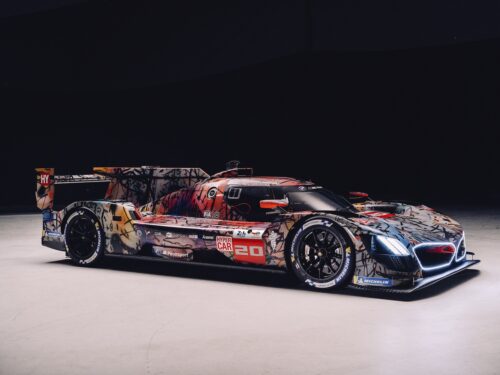
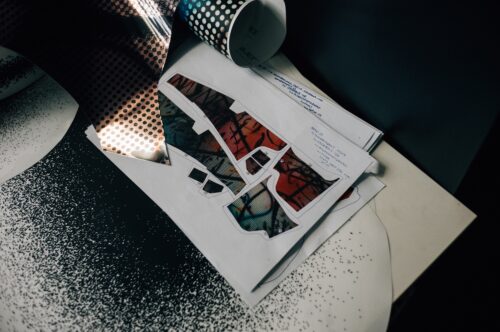
Many of her works continue to oscillate between drawing and painting and require the viewer to capture them from different perspectives and distances. Whereby »capture« is certainly the wrong word in the context of her flickering, often large-format paintings consisting of countless layers. If you throw yourself into them, you still have the many gestural markings she has made to hold on to—as if to lifebuoys—, but at best you simply let yourself drift. Or to return to the concept of opacity: Examining her paintings in their entirety should by no means be the declared aim. Even with art-historically trained X-ray vision, one would not succeed in penetrating her works completely. In an interview with Flash Art Magazine, she told of a critic who was trying to get to the bottom of one of her paintings, who literally wanted to look all the way to the bottom, ignoring the »opacity«: »I remember, I even had a critic ask me one time. ›Well what does this mark mean?‹ He literally went through the piece and asked about every mark.«
»…In a world so dominated by algorithms, making a mark on a piece of paper is, for me, an action that exists outside this system.«
CROSSING BORDERS
You don’t need the aforementioned X-ray vision to find out about Julie Mehretu’s career to date. In interviews, she talks openly and at length about the many moves she made in her childhood and youth, which would later shape her art. »There was this military dictatorship in Ethiopia, and it was a hairy moment where the government was eradicating intelligentsia and intellectuals«, says the daughter of a university professor of geography and a Montessori teacher. She says about her artistic beginnings: »When I started my MFA, I was making big, abstract oil paintings that looked gestural and expressionistic, even though I wasn’t interested in them looking like that.«
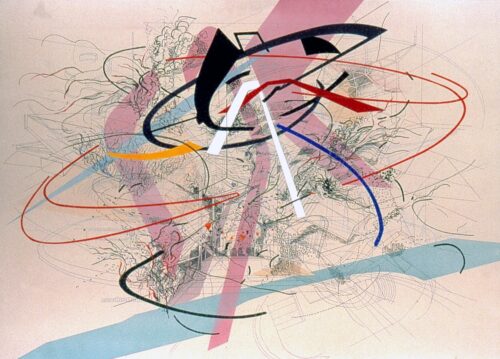
»Untitled 1«, 2001
Ink and acrylic on canvas
152.4 × 213.4 cm
When you meet Julie Mehretu, you are confronted with a person who puts her heart and soul into making art, but who does not want to embody any attributions that are imposed on her from the outside. She does not fit into any pigeonhole—not only because of the size of many of her best-known paintings. Julie Mehretu is also an artist who, as she explains in the interview, has become increasingly interested in the activist side of her artistic work over the course of her career. When asked what exactly she understands by this, she answers as follows: »There are so many things happening in our world, mainly due to technological progress that is just hurtling along, that give us the feeling that we as human beings hardly have any individual freedom of action anymore. I’m not talking about excessive individualism, but rather about having the feeling as an individual that you can actively shape your own environment—perhaps even bring about change. I firmly believe that drawing is a very intimate and immediate form of insisting on being here. As well as an insistence on precisely these individual possibilities. In a world so dominated by algorithms, making a mark on a piece of paper is, for me, an action that exists outside of that system.«
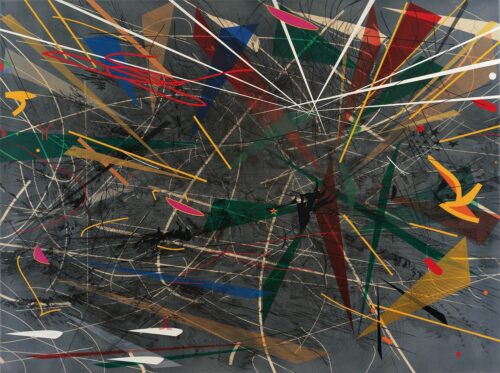
»Black Ground (deep light)«, 2006
Ink and acrylic on canvas
182.9 × 243.8 cm
However, this also means that the BMW Art Car will not be retired after its grand appearance at the 24 Hours of Le Mans, but will demonstrate its endurance in a completely different form. The collaboration between Julie Mehretu and BMW will continue in 2025 with the »PanAfrican Translocal Media Workshop Series« on the African continent. Together with Mehret Mandefro, Emmy-nominated producer, author and co-founder of the Realness Institute which works to strengthen the media ecosystem across Africa, Julie Mehretu will host workshops in eight African cities over the course of nine months to provide a space for artists to meet, share and collaborate. The results of the workshops will then be exhibited at the Zeitz Museum of Contemporary Art Africa in Cape Town – together with the 20th BMW Art Car. The central partner for the conception of the program is the artist residency founded in 2004 by Julie Mehretu, Lawrence Chua and Paul Pfeiffer Denniston Hill in upstate New York. She adds that the second part of her collaboration with BMW was also about testing out what this car can (be). »Really pushing the imagination of what this car could be« is a phrase that comes up several times during our interview and, beyond the BMW Art Car, is characteristic of her work. It is also fitting that she sees her artistic works as »space for possibility and for invention«. »In terms of actual social change, it will not alleviate many systemic problems we have, such as our really shitty education system or poverty or hunger. But I think there’s room for many levels of working on social change.«
FROM THE ABSTRACT TO THE CONCRETE
Although Julie Mehretu’s artistic work is, of course, primarily about abstraction, we would like to mention a few concrete figures. Her 7 × 24 meter mural »Mural« hangs in the lobby of the Goldman Sachs headquarters and was described by the American art critic Calvin Tomkins as »the most ambitious painting I’ve seen in a dozen years«. Her painting »Untitled 1« (2001) was sold at Sotheby’s auction house in 2010 for more than one million US dollars and her work »Black Ground (deep light)« (2006) was auctioned at Sotheby’s in Hong Kong for 5.6 million US dollars. »Untitled« (2001) was sold at auction—also at Sotheby’s in Hong Kong—for 9.32 million US dollars. In 2023, the entrepreneur Michael Ovitz sold Julie Mehretu’s »Walkers With the Dawn and Morning« (2008) for 10.7 million dollars. Never before had a work of art by a BIPOC artist achieved a higher sum. In 2005, she also received the prestigious »Genius Grant« from the MacArthur Foundation and the U.S. State Department Medal of Arts in 2015.
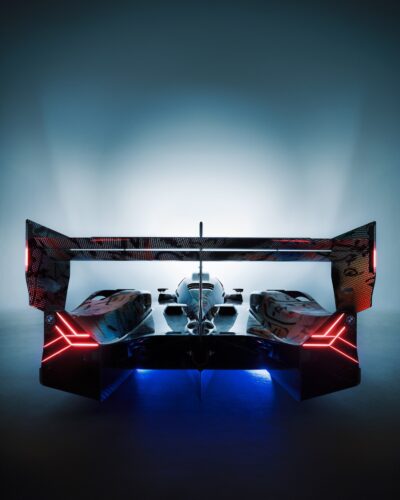
Considering that Julie Mehretu has just completed the opening of the most comprehensive exhibition of her works in Europe to date at the time of our interview, she seems extraordinarily relaxed and at ease. »Ensemble« was the title of the exhibition, which was on display at the Palazzo Grassi in Venice until January 6, 2025. The name said it all, as her own paintings enter into an exciting dialog with works by fellow artists such as Nairy Baghramian, Huma Bhabha, Tacita Dean, David Hammons, Robin Coste Lewis, Paul Pfeiffer and Jessica Rankin. We quickly ask her whether she finds it easy to look back with satisfaction on the work she has created so far before the window of the video conference app closes again. »Sometimes, of course, I think about whether I might have done something differently here and there, but in the end the pictures are what they are. But sometimes I also look at a picture of myself and think: Wow, how did you actually manage that?« Would the Art Car have given you the same feeling of satisfaction? »Absolutely. I’ve just come back from the studio and saw the model there. It looks fantastic!« She laughs and we say goodbye. Spring is probably still tickling her nose. And there’s a pretty good chance that Julie Mehretu’s fingers are already tingling again. There are many more frames to break.

